- Home
- Alan Bennett
The Lady in the Van Page 3
The Lady in the Van Read online
Page 3
The crucial shot of the day (still raining) comes when the dead Miss Shepherd reappears from the grave and discovers the young biker whom she’s always thought she’d killed having a fag behind a gravestone. She walks off with him arm in arm into her own personal sunset and as she does so lets out a cackle. ‘Mr Bennett. Do you know what that is? It’s the last laugh!’ Thereafter … and by some technical wizardry I don’t understand … she will ascend into heaven.
12 November
To the National Theatre where Alex J. is filmed on the stage of the Lyttelton, set up for part of the Talking Heads monologue ‘A Chip in the Sugar’. It was when we were previewing the stage production at Guildford that I dried three times during the same performance, the stage fright that resulted curing me of any desire to act on the stage. It’s a year ago now since the National Theatre Fiftieth Anniversary Gala where I played Richard Griffiths’s role in an extract from The History Boys and the terror has not subsided. Talk I can do and read but act (and, essentially, remember), not anymore.
13 November
One of the small pleasures of living in Gloucester Crescent/NW1 and one which went unmentioned in the (ever more lavish) brochures put out by the (ever more present) estate agents was waking around six in the morning to the sound of distant horses. Still in those days billeted in St John’s Wood the King’s Troop regularly exercised in Regent’s Park, which would occasionally bring them along Oval Road and down the Crescent. The ancient sound of horsemen carried in the early morning air so one would hear the troop long before they cantered into view, twenty or thirty horses, with each khaki-clad soldier leading another riderless mount.
The mood of this troop was often quite festive and carefree, in spring a rider plucking down a gout of cherry blossom and putting it in his hat, and in winter there would be some sly snowballing. I always got up to watch them go by and on occasion Miss Shepherd would observe her own stand-to, a young soldier once giving her a mock salute. In summer I fancy they were in shirt-sleeve order, but even when they were more formally dressed it was a relaxed performance, which in winter was made more romantic as the riders materialised out of the gloom, preceded by a lone horseman with a lantern, another outrider with a lamp bringing up the rear. Somewhere in London I imagine this spectacle still goes on but St John’s Wood Barracks has gone and it’s Camden Town’s loss—and since the Guards can’t trek over from Hyde Park, the film’s loss too.
November, Shoreditch Town Hall
Today we film the young Miss Shepherd as the soloist in a symphony concert in the forties playing Chopin’s First Piano Concerto.
I lived briefly in Shoreditch when I first came to London in 1961, lodging with some friends from Oxford in Worship Street, cycling to work during the day at the Public Record Office then in Chancery Lane and in the evening at the Fortune Theatre, where I was in the revue Beyond the Fringe. The house where we all lived was designed by Philip Webb, the disciple of William Morris, and was something of a social departure, one of a terrace of model dwellings with workshops on the ground floor and accommodation above. Happily it still stands and is now listed. Shoreditch then had little to recommend it, a quarter of small factories and workshops, greasy spoon cafes and furniture menders. Having scarcely been in the neighbourhood since, I am taken aback by how smart and indeed trendy it seems to be, the Victorian tenements and cottages gentrified, the streets lined with modish shops and eateries. The Town Hall, though, has not changed and its elaborately tiled and plastered hall this morning hosts the London Symphony Orchestra, who are being conducted by George Fenton. Wearing his father’s tails he has been given a moustache in order to suggest a young Adrian Boult, the famous conductor … a forlorn attempt as Adrian Boult can never have been young and if George looks like anybody it’s Flash Harry, Malcolm Sargent. Happily he’s not just acting the conductor, having in his time waved his baton (one of Karajan’s batons) at the Berlin Philharmonic and the LA Philharmonic. The young soloist, Clare Hammond, plays well too and filmed in longish takes the music is a pleasure to listen to. Half my life is here, I think as I sit listening, as George was in my first play, Forty Years On, and learned his music sitting beside the conductor and composer Carl Davis, who played the school organist of Albion House.
I have allowed myself a little leeway in speculating about Miss Shepherd’s concert career, except that if, as her brother said, she had studied with Alfred Cortot she must have been a pianist of some ability. Cortot was the leading French pianist between the wars, Miss Shepherd presumably studying with him at the height of his fame. Continuing to give concerts throughout the Occupation, he finished the war under a cloud and it was perhaps this that sent him on a concert tour to England, where I remember seeing his photograph on posters some time in the late forties. Perhaps Miss Shepherd saw it too, though by this time her hopes of a concert career must have been fading, a vocation as a nun already her goal.
Her war had been spent driving ambulances, a job for which she had presumably enlisted and been trained and which marked the beginning of her lifelong fascination with anything on wheels. Comically she figures in my mind alongside the Queen who, as Princess Elizabeth, also did war service and as an ATS recruit was filmed in a famous piece of wartime propaganda changing the wheel on an army lorry, a vehicle my mother fondly believed HRH drove for the duration of hostilities.
What with land girls, nurses, Waafs, the ATS and Wrens, these were years of cheerful, confident, seemingly carefree women and I’d like to think of Miss Shepherd as briefly one of them, having the time of her life: accompanying a singsong in the NAAFI (Navy, Army and Air Force Institutes) perhaps, snatching a meal in a British restaurant, then going to the pictures to see Leslie Howard or Joan Fontaine. It was maybe this taste of wartime independence that later unsuited her for the veil or it may be, as her brother suggested, that she suffered shellshock after a bomb exploded near her ambulance. At any rate she was invalided out and this was when her troubles began, with, in her brother’s view, the call of the convent a part of it.
I would have liked her concert career to have outlasted the war or to have resumed after the duration, when the notion of a woman playing the piano against the psychological odds was the theme of the film The Seventh Veil (1945) with Ann Todd as the pianist Francesca and James Mason her tyrannical stick-wielding Svengali. Enormously popular at the time (and with it the Grieg Piano Concerto), the film set the tone for a generation of glamorous pianists, best known of whom was Eileen Joyce, who was reputed to change her frock between movements.
The Seventh Veil was subsequently adapted for the stage and I still have the programme of the matinee I saw at the Grand Theatre in Leeds in March 1951. The Grieg Concerto had by this time been replaced by Rachmaninov No. 2 and James Mason by Leo Genn, but it was still Ann Todd, her guardian as ever bringing his stick down across her fingers as she cowered at the keyboard.
If Miss Shepherd had ever made it to the concert circuit this would be when I might have seen her, as I was by now going every week to symphony concerts in Leeds Town Hall where Miss Shepherd would have taken her place alongside Daphne Spottiswoode or Phyllis Sellick, Moura Lympany, Valda Aveling and Gina Bachauer—artistes with their décolleté shawl-collared gowns as glamorous and imposing in my fourteen-year-old eyes as fashion models, Barbara Goalens of the keyboard, brought to their feet by the conductor to acknowledge the applause, clutching to their bosoms the bouquets which they were invariably presented, to which Miss Shepherd on the last night of her life contemptuously compares the scrutty bunch of anemones which AB brings her.
And it was the last night of her life. When I wrote the original account I glossed over the fact that Miss Shepherd’s death occurred the same night that, washed and in clean things, she returned from the day centre. I chose not to make this plain because for Miss Shepherd to die then seemed so handy and convenient, just when a writer would (if a little obviously) have chosen for her to die. So I note that I was nervous not only of altering the facts to suit t
he drama but of even seeming to have altered them.
25 November
Today is the last day of shooting and it’s as cold and wet as it was six weeks ago when we started. Today comes the last of the ex-History Boys, Russell Tovey, who plays a dubious youth, and whom I at first don’t recognise because of his curly black wig. He only has one line, ‘Who’s the old bat?’ but as he passes the van Maggie has to stick her head out and look after him as he goes.
MISS S.: Mr Bennett. That young man. Did he have an earring?
AB: He did.
MISS S.: You want to be careful …
* * *
Don’t go around saying goodbye as at this stage I’m going to the Wrap Party but when Thursday night comes I can’t face it.
There is an odd footnote to Miss Shepherd’s story that persists into the present day, as resident in Chiswick until her death quite recently was another lady in a van. This might not seem so odd except that she, too, had been a pianist and was as averse to publicity as Miss Shepherd ever was. When I first heard of her I felt somehow she was a rival and somehow disauthenticated the story of my lady in the van. That’s absurd, though of one thing I’m sure: Miss Shepherd would not have been pleased.
Miss Shepherd was solipsistic to a degree and, in her persistent refusal to take into account the concerns or feelings of anyone else except herself and her inability to see the world and what happened in it except as it affected her, she behaved more like a man than a woman. I took this undeviating selfishness to have something to do with staying alive. Gratitude, humility, forgiveness or fellow feelings were foreign to her nature or had become so over the years, but had she been otherwise she might not have survived as long as she did. She hated noise, though she made plenty, particularly when sitting in her three-wheeler on a Sunday morning revving the engine to recharge the battery. She hated children. Reluctant to have the police called when the van’s window had been broken and herself hurt, she would want the law summoned if there were children playing in the street and making what she considered too much noise or indeed any noise at all.
She inhabited a different world from ordinary humanity, a world in which the Virgin Mary would be encountered outside the Post Office in Parkway and Mr Khrushchev higher up the street; a world in which her advice was welcomed by world leaders and the College of Cardinals took note of her opinion. Seeing herself as the centre of the world, she had great faith in the power of the individual voice, even when it could only be heard through pamphlets photocopied at Prontaprint or read on the pavement outside Williams and Glyn’s Bank.
I never questioned Miss Shepherd on the subject but what intrigued me about the regular appearances put in by the Virgin Mary was that she seldom turned up in her traditional habiliments; no sky-blue veil for her, still less a halo. Before leaving heaven for earth the BVM always seemed to go through the dressing-up box so that she could come down as Queen Victoria, say, or dressed in what sounded very much like a sari. And not only her. One of my father’s posthumous appearances was as a Victorian statesman, and an old tramp, grey-haired and not undistinguished, was confidently identified as St Joseph (minus his donkey), just as I was taken briefly for St John.
With their fancy dress and a good deal of gliding about, it was hard not to find Miss Shepherd’s visions comic, but they were evidence of a faith that manifestly sustained her and a component of her daily and difficult life. In one of her pamphlets she mentioned the poet Francis Thompson, who was a Catholic as she was (and who lived in similar squalor). Her vision of the intermingling of this world and the next was not unlike his:
But (when so sad thou canst not sadder)
Cry:—and upon thy so sore loss
Shall shine the traffic of Jacob’s ladder
Pitched betwixt heaven and Charing Cross.
Yea, in the night, my Soul, my daughter,
Cry,—clinging Heaven by the hems;
And lo, Christ walking on the water
Not of Gennesareth, but Thames!
It’s now over a quarter of a century since Miss Shepherd died, but hearing a van door slide shut will still take me back to the time when she was in the garden. For Marcel, the narrator in Proust’s Remembrance of Things Past, the sound that took him back was that of the gate of his aunt’s idyllic garden; with me it’s the door of a broken-down Commer van. The discrepancy is depressing but then most writers discover quite early on that they’re not going to be Proust. Besides, I couldn’t have heard my own garden gate because in order to deaden the (to her) irritating noise Miss Shepherd had insisted on me putting a piece of chewing gum on the latch.
Alan Bennett, April 2015
The Lady in the Van
Good nature, or what is often considered as such, is the most selfish of all virtues: it is nine times out of ten mere indolence of disposition.
—WILLIAM HAZLITT, ‘ON THE KNOWLEDGE OF CHARACTER’ (1822)
‘I RAN INTO A SNAKE this afternoon,’ Miss Shepherd said. ‘It was coming up Parkway. It was a long, grey snake—a boa constrictor possibly. It looked poisonous. It was keeping close to the wall and seemed to know its way. I’ve a feeling it may have been heading for the van.’ I was relieved that on this occasion she didn’t demand that I ring the police, as she regularly did if anything out of the ordinary occurred. Perhaps this was too out of the ordinary (though it turned out the pet shop in Parkway had been broken into the previous night, so she may have seen a snake). She brought her mug over and I made her a drink, which she took back to the van. ‘I thought I’d better tell you,’ she said, ‘just to be on the safe side. I’ve had some close shaves with snakes.’
This encounter with the putative boa constrictor was in the summer of 1971, when Miss Shepherd and her van had for some months been at a permanent halt opposite my house in Camden Town. I had first come across her a few years previously, stood by her van, stalled as usual, near the convent at the top of the street. The convent (which was to have a subsequent career as the Japanese School) was a gaunt reformatory-like building that housed a dwindling garrison of aged nuns and was notable for a striking crucifix attached to the wall overlooking the traffic lights. There was something about the position of Christ, pressing himself against the grim pebbledash beneath the barred windows of the convent, that called up visions of the Stalag and the searchlight and which had caused us to dub him ‘The Christ of Colditz’. Miss Shepherd, not looking un-crucified herself, was standing by her vehicle in an attitude with which I was to become very familiar, left arm extended with the palm flat against the side of the van indicating ownership, the right arm summoning anyone who was fool enough to take notice of her, on this occasion me. Nearly six foot, she was a commanding figure, and would have been more so had she not been kitted out in greasy raincoat, orange skirt, Ben Hogan golfing-cap and carpet slippers. She would be going on sixty at this time.
She must have prevailed on me to push the van as far as Albany Street, though I recall nothing of the exchange. What I do remember was being overtaken by two policemen in a panda car as I trundled the van across Gloucester Bridge; I thought that, as the van was certainly holding up the traffic, they might have lent a hand. They were wiser than I knew. The other feature of this first run-in with Miss Shepherd was her driving technique. Scarcely had I put my shoulder to the back of the van, an old Bedford, than a long arm was stretched elegantly out of the driver’s window to indicate in textbook fashion that she (or rather I) was moving off. A few yards further on, as we were about to turn into Albany Street, the arm emerged again, twirling elaborately in the air to indicate that we were branching left, the movement done with such boneless grace that this section of the Highway Code might have been choreographed by Petipa with Ulanova at the wheel. Her ‘I am coming to a halt’ was less poised, as she had plainly not expected me to give up pushing and shouted angrily back that it was the other end of Albany Street she wanted, a mile further on. But I had had enough by this time and left her there, with no thanks for my trouble. Far from it. She
even climbed out of the van and came running after me, shouting that I had no business abandoning her, so that passers-by looked at me as if I had done some injury to this pathetic scarecrow. ‘Some people!’ I suppose I thought, feeling foolish that I’d been taken for a ride (or taken her for one) and cross that I’d fared worse than if I’d never lifted a finger, these mixed feelings to be the invariable aftermath of any transaction involving Miss Shepherd. One seldom was able to do her a good turn without some thoughts of strangulation.
It must have been a year or so after this, and so some time in the late sixties, that the van first appeared in Gloucester Crescent. In those days the street was still a bit of a mixture. Its large semi-detached villas had originally been built to house the Victorian middle class, then it had gone down in the world, and, though it had never entirely decayed, many of the villas degenerated into rooming houses and so were among the earliest candidates for what is now called ‘gentrification’ but which was then called ‘knocking through’. Young professional couples, many of them in journalism or television, bought up the houses, converted them and (an invariable feature of such conversions) knocked the basement rooms together to form a large kitchen/dining-room. In the mid-sixties I wrote a BBC TV series, Life in NWI, based on one such family, the Stringalongs, whom Mark Boxer then took over to people a cartoon strip in the Listener, and who kept cropping up in his drawings for the rest of his life. What made the social set-up funny was the disparity between the style in which the new arrivals found themselves able to live and their progressive opinions: guilt, put simply, which today’s gentrifiers are said famously not to feel (or ‘not to have a problem about’). We did have a problem, though I’m not sure we were any better for it. There was a gap between our social position and our social obligations. It was in this gap that Miss Shepherd (in her van) was able to live.

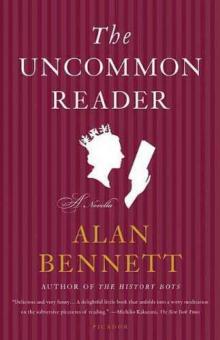 The Uncommon Reader: A Novella
The Uncommon Reader: A Novella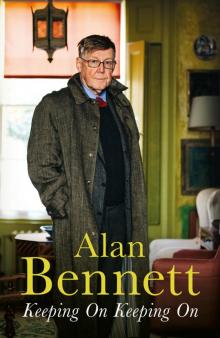 Keeping On Keeping On
Keeping On Keeping On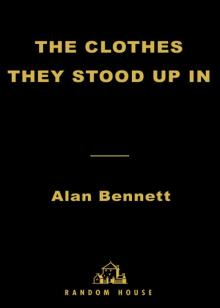 The Clothes They Stood Up In
The Clothes They Stood Up In Smut: Stories
Smut: Stories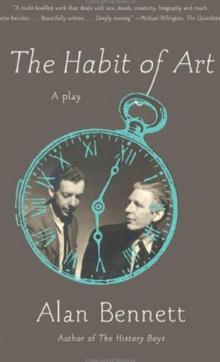 The Habit of Art: A Play
The Habit of Art: A Play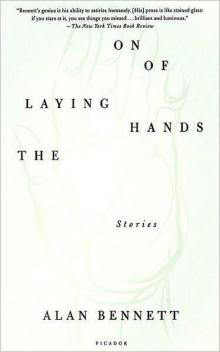 The Laying on of Hands: Stories
The Laying on of Hands: Stories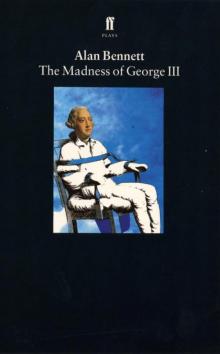 The Madness of George III
The Madness of George III Writing Home
Writing Home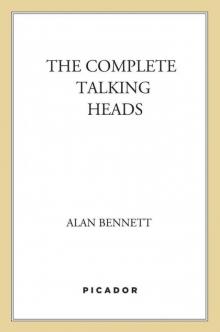 The Complete Talking Heads
The Complete Talking Heads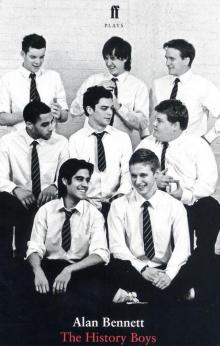 The History Boys
The History Boys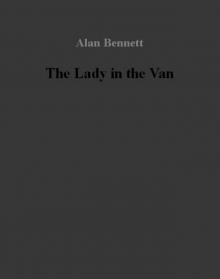 Lady in the Van
Lady in the Van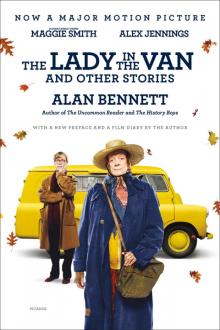 The Lady in the Van
The Lady in the Van Four Stories
Four Stories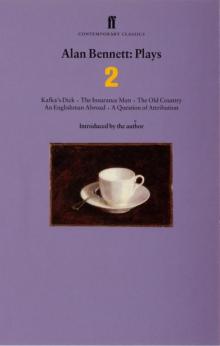 Alan Bennett: Plays, Volume 2
Alan Bennett: Plays, Volume 2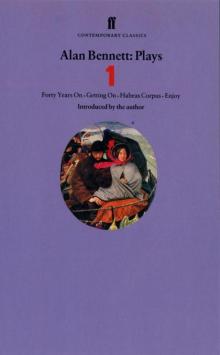 Alan Bennett: Plays, Volume 1
Alan Bennett: Plays, Volume 1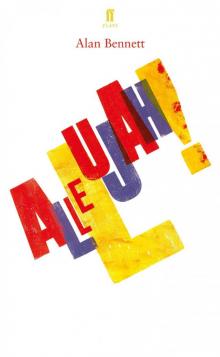 Allelujah!
Allelujah! Untold Stories
Untold Stories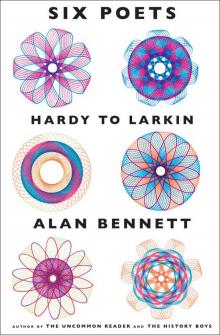 Six Poets
Six Poets